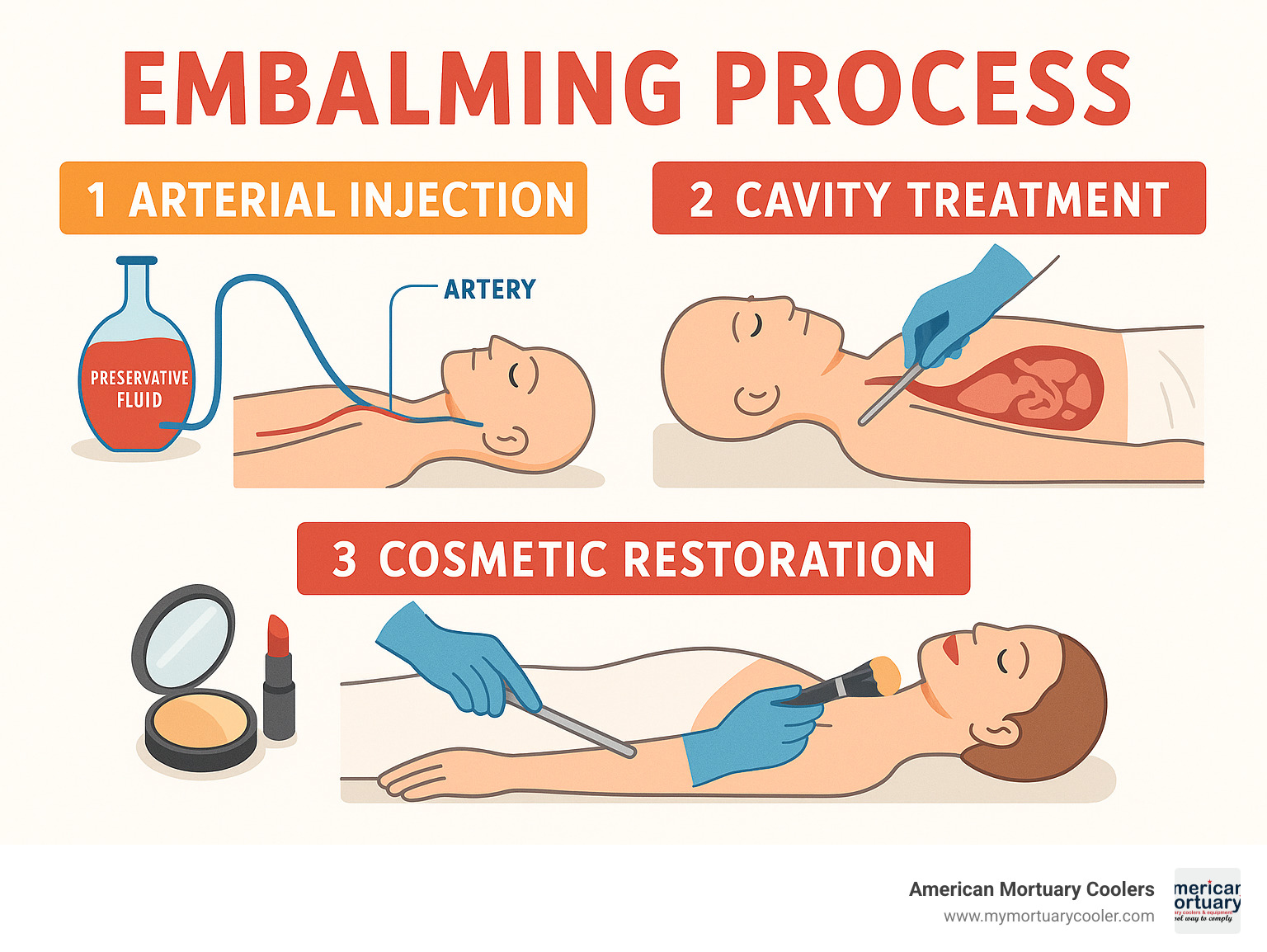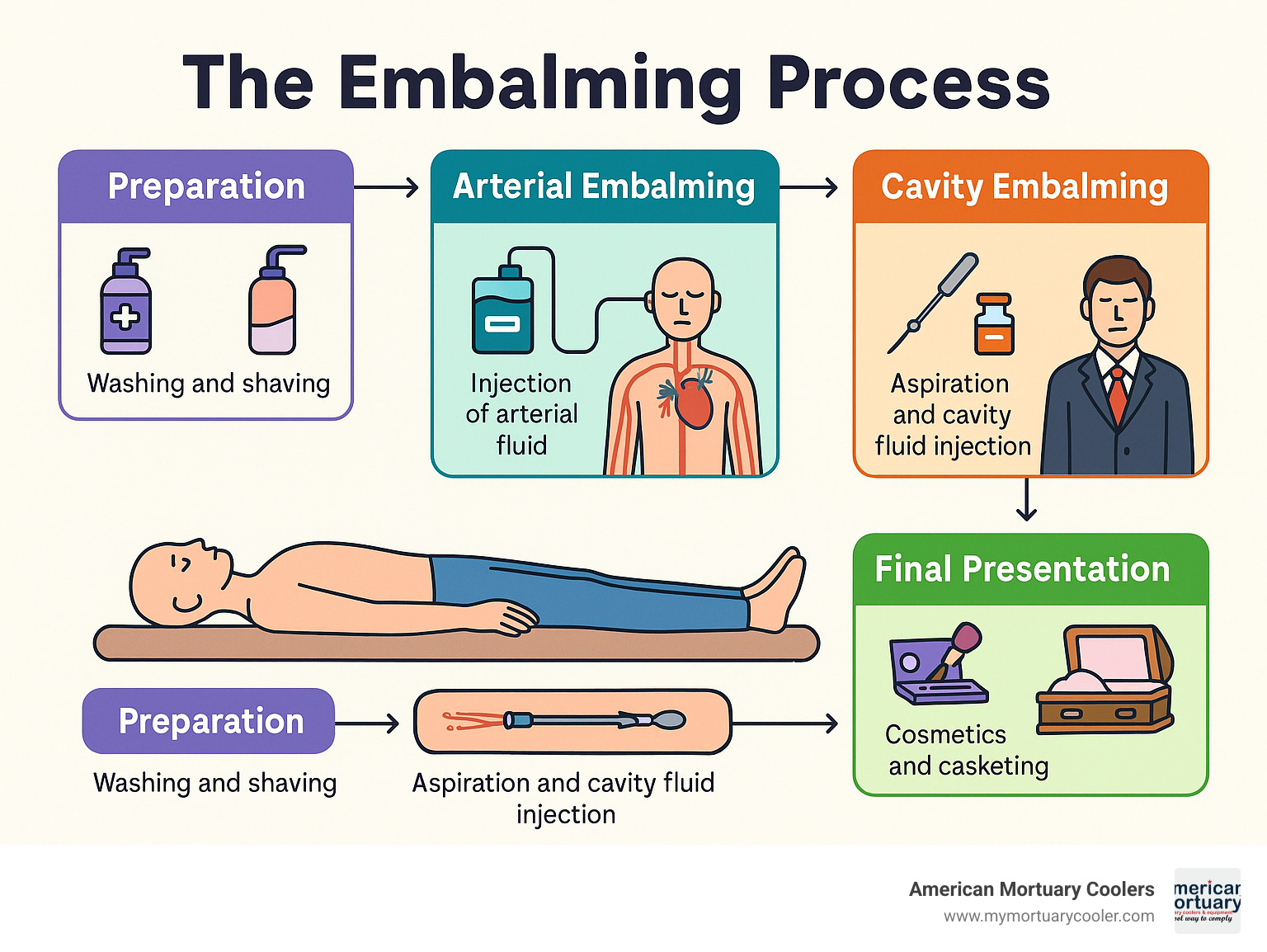Understanding the Art and Science of Embalming
Embalming is the process of preserving and sanitizing human remains by treating them with chemicals to delay decomposition. This procedure serves three main purposes: preservation, sanitation, and presentation of the deceased for viewing.
| What is Embalming? | Key Details |
|---|---|
| Definition | A chemical process that preserves human remains by replacing blood with formaldehyde-based solutions |
| Purpose | Prevents decomposition, sanitizes the body, and prepares it for viewing |
| Duration | Typically takes 2-4 hours to complete |
| Preservation Time | Usually preserves a body for about one week |
| Legal Requirement | Not legally required in most cases except for interstate transport or certain infectious diseases |
Embalming combines technical skill with artistic restoration to create a peaceful, natural appearance for the deceased. The process developed significantly during the American Civil War when there was a need to preserve soldiers' bodies for transport home to their families. Today, it remains common practice in the United States and Canada, though it's less prevalent in other parts of the world.
While not required by law in most situations, embalming provides families with time to gather for viewings and funeral services. It also allows for open-casket ceremonies that many find helpful in the grieving process.
Modern embalming involves several key steps:
- Washing and disinfecting the body
- Replacing blood with preservative chemicals through arterial injection
- Treating internal organs with preservative fluids
- Setting facial features and applying cosmetics
I'm Mortuary Cooler, with over 15 years of experience supplying mortuary equipment to funeral homes nationwide and working closely with embalmers to understand their equipment needs for the embalming process. My expertise helps funeral directors maintain optimal conditions for body preservation when embalming isn't immediately possible.

Embalming Across Millennia: History, Purpose & Benefits
The story of preserving our departed loved ones stretches back through the mists of time. While the ancient Egyptians might first come to mind with their elaborate mummification rituals dating to around 2600 BCE, they weren't actually the pioneers. That distinction belongs to the Chinchorro people of present-day Chile, who began preserving their dead between 5000-6000 BCE—creating what are now among our oldest artificially preserved human remains.
Throughout human history, different cultures developed their own preservation methods. The Bible mentions embalming, notably with Joseph's body in Egypt. But the embalming we recognize today has much more recent roots, taking shape primarily in the 19th century.
The American Civil War (1861-1865) transformed embalming from an occasional practice to a practical necessity. As soldiers fell on battlefields far from home, families desperately wanted their loved ones returned for proper burial. Thomas Holmes—often called the "father of modern embalming"—seized this moment, developing field techniques that preserved bodies for the journey home. During the conflict, Holmes personally embalmed over 4,000 soldiers, forever changing funeral practices in America.
A game-changing breakthrough arrived in the 1890s with the findy that formaldehyde effectively preserved human tissue. This finding revolutionized embalming, replacing the toxic arsenic-based solutions previously used and establishing the foundation for techniques still employed today.

Modern embalming serves several vital purposes for families and communities. It sanitizes the body, preventing the spread of disease. It preserves the remains by delaying natural decomposition. It restores a peaceful appearance for viewing, often providing families with their final memory of their loved one. It enables safe transportation over long distances, and perhaps most importantly, it gives families precious time to gather for meaningful funeral services.
From Mummies to Modern Science
The journey from ancient preservation to today's scientific embalming reflects our advancing understanding of human anatomy. Ancient Egyptians carefully dehydrated bodies using natron (a natural salt mixture) before carefully wrapping them in approximately 1,200 yards of linen bandages. They removed internal organs, preserving them separately in decorative canopic jars.
During the Middle Ages and Renaissance, anatomical study drove innovation in preservation techniques. Scientists like Leonardo da Vinci needed preserved specimens for their groundbreaking research. By the 17th century, Dutch anatomist Frederick Ruysch had pioneered arterial injection methods that foreshadowed modern approaches.
Why Families Choose Embalming
Today's families choose embalming for both practical and deeply emotional reasons. Many cultural and religious traditions include viewing the deceased as an essential part of the funeral ritual. Embalming creates a more peaceful appearance, helping families begin their grief journey with a final, gentle image of their loved one.
When death occurs far from the intended burial place, embalming becomes not just helpful but often legally required for transporting remains across state lines or internationally. In our mobile society, this happens frequently.
For a deeper scientific understanding of human body preservation techniques, the Scientific research on human body preservation provides valuable insights into both historical methods and current best practices.
The Modern Embalming Process: Step-by-Step Guide
When we talk about modern embalming, we're looking at a careful, methodical process that typically takes between two and four hours. The time varies depending on the condition of the remains and specific techniques needed. While I've supplied cooling equipment to funeral homes for years, I've watched skilled embalmers work their craft with both precision and compassion.
The complete embalming process unfolds through several distinct stages, each serving a specific purpose in preserving and preparing the deceased. From initial preparation to final presentation, each step builds upon the last to create a dignified appearance for the family's final viewing.
Most embalmers use approximately 3 gallons of solution during the procedure – a carefully mixed combination of embalming fluid and water that circulates throughout the body. Many solutions contain a subtle pink dye that not only gives the skin a more lifelike appearance but also helps the embalmer visually track how well the fluid is distributing throughout the tissues.
Pre-Embalming Preparation
Before the chemical preservation begins, several important preparatory steps set the foundation for success.
First, the embalmer verifies the identity of the deceased and reviews relevant medical information, including cause of death and any infectious disease concerns that might require special handling. Personal belongings are carefully cataloged, with jewelry either removed for safekeeping or secured in place according to the family's wishes.
The body receives a thorough washing with germicidal soap and disinfectant sprays – a crucial step that sanitizes the surface and reduces potential infection risks for the embalmer. Next comes the gentle massage of limbs to relieve rigor mortis, allowing for natural positioning that will look restful and peaceful during viewing.
Arterial Embalming
Arterial embalming forms the cornerstone of modern preservation techniques. The process begins when the embalmer makes a small, discreet incision, typically at the neck or groin, to access a major artery and vein. Most commonly, they'll use the right common carotid artery for injection paired with the right internal jugular vein for drainage.
Once the vessels are accessed, the embalmer inserts and secures tubes – an injection tube in the artery and a drainage tube in the vein. Using either a gravity-fed system or mechanical pump, they introduce embalming fluid into the arterial system at a controlled pressure, typically between 3-12 psi. This solution gradually replaces the blood, which exits through the drainage tube.
Throughout this process, the embalmer watches for signs of good distribution – slight firming of tissues, pinking of the skin, and drainage color changes. They massage the body to ensure even distribution and break up any blood clots that might block fluid flow.

Cavity Embalming
After completing the arterial work, attention turns to the internal organs within the thoracic and abdominal cavities. Since these organs aren't effectively reached through the bloodstream, they require direct treatment.
The embalmer uses a specialized instrument called a trocar – essentially a long, hollow needle with a sharp point – and inserts it through a small incision located about two inches above and to the left of the navel (umbilicus). This traditional entry point gives direct access to both the abdominal and thoracic cavities while keeping the puncture hidden beneath clothing.
The trocar connects to a suction pump (aspirator) that removes gases and fluids from body cavities and hollow organs. This crucial step prevents the bloating that would otherwise occur as organs naturally decompose.
Once aspiration is complete, the trocar is connected to a container of concentrated cavity fluid. About 32-36 ounces of this stronger preservation solution are injected directly into the thoracic and abdominal organs. The average adult body contains 15-25 pounds of viscera requiring this treatment – organs like the stomach, intestines, and lungs that arterial embalming simply can't reach effectively.
After injection, the trocar puncture site is sealed with a special trocar button or sutured closed to prevent any leakage.
Finishing Touches & Presentation
The final stage focuses on creating a peaceful, natural appearance that brings comfort to the family. This begins with another thorough washing, followed by hair shampooing and styling according to family wishes or photographs. For men, shaving may be performed, with careful attention to ear and nose hairs.
The embalmer gently closes the eyes using specialized eye caps that sit beneath the eyelids, creating a natural resting appearance. The mouth is positioned using sutures, wires, or special adhesives to create a natural expression – not a smile, but a peaceful resting look.

Techniques, Special Cases, and Essential Equipment
Every embalming journey is unique, much like the individuals being cared for. Having spent years working with funeral professionals, I've seen how different situations call for creative approaches and specialized tools to achieve that peaceful final appearance families deserve.
Special Case Techniques
When a loved one has undergone an autopsy, embalmers face a more complex preservation challenge. The organs, having been examined, typically return in what we call a viscera bag. The embalmer must carefully treat these organs separately, often by giving them a gentle bath in cavity fluid before returning them to their proper place. Because blood vessels have been severed during the procedure, multiple injection points become necessary to ensure complete preservation.
Trauma cases require an entirely different level of artistry. I've spoken with embalmers who describe this work as "the ultimate form of care" – using specialized waxes, fillers and cosmetics to reconstruct damaged areas with dignity. Tissue building compounds help restore natural contours, while targeted surface embalming with specialized gels addresses specific areas of concern.
Essential Equipment
Behind every successful embalming stands reliable equipment that blends art with science. Modern embalming machines electronically control both pressure and flow rate with remarkable precision. The Portiboy – a portable embalming machine – has become something of an industry standard in many funeral homes for its reliability and convenience.
Arterial tubes come in various shapes and sizes, including curved and straight designs with slip hubs that create secure connections. Drainage tubes efficiently remove blood during the arterial process. Trocars – those long, hollow pointed instruments essential for cavity embalming – come in different sizes to address various body types and needs.

Hypodermic & Surface Embalming
While arterial and cavity methods form the foundation of modern preservation, two supplementary techniques often provide that extra care needed for complete preservation.
Hypodermic embalming is like adding the final brushstrokes to a painting. Using a hypodermic needle, embalmers directly inject preservation fluid into tissues that arterial fluid might not have fully reached – typically hands, feet, and facial features. This approach proves essential for bodies with compromised circulation or vascular blockages.
Surface embalming involves directly applying preservative chemicals to the skin and exposed tissues using sprays, gels, or soaked packs. I've watched skilled embalmers apply these with remarkable precision, particularly around areas with breaks in the skin or autopsy incisions.
Embalming for Anatomical Study
Embalming for medical education follows an entirely different path than funeral preparation. While both honor the deceased, their purposes diverge significantly. Medical specimens typically use formaldehyde concentrations of 37-40% – substantially higher than funeral preparations – because these bodies must serve as teachers for months or even years rather than days.
| Aspect | Funeral Embalming | Anatomical Embalming |
|---|---|---|
| Primary Purpose | Presentation and short-term preservation | Long-term preservation for study |
| Formaldehyde Concentration | 5-35% | 37-40% |
| Cosmetic Work | Extensive | None |
| Duration of Preservation | ~1 week | Months to years |
Chemicals, Safety, and Environmental Impact
Behind the art of embalming lies a complex science of chemical preservation. These chemicals are essential for the process, but they also come with important health and environmental considerations that every funeral professional needs to understand.
When I visit funeral homes to install our mortuary coolers, I often notice the careful attention paid to chemical storage and handling. There's good reason for this caution – modern embalming fluids contain powerful preservatives that require respect and proper handling.
Common Embalming Chemicals
The chemistry of modern embalming is fascinating and sophisticated. The primary ingredient in most formulations is formaldehyde, typically making up 5-35% of the solution. This powerful preservative works by cross-linking proteins in the tissues, essentially preventing decomposition by stabilizing cellular structures.
But formaldehyde doesn't work alone. Methanol (9-56%) serves as both solvent and carrier, helping the formaldehyde penetrate tissues effectively. Some newer formulations incorporate glutaraldehyde as an alternative preservative that causes less respiratory irritation while maintaining effectiveness.
A well-formulated embalming fluid also contains humectants like glycerin, lanolin, and sorbitol that prevent tissues from becoming too dehydrated. Wetting agents help the solution penetrate more effectively, while anticoagulants ensure blood clots don't block the fluid's distribution through the vascular system.
Health Protocols for Embalmers
Working with embalming chemicals requires serious safety measures. As one seasoned embalmer told me, "Every human remain should be treated as a potential hazardous condition—best rule of thumb." This cautious approach protects professionals from both chemical and biological hazards.
OSHA classifies formaldehyde as a carcinogen and respiratory irritant, requiring embalmers to wear proper respirators during the embalming process. Full-body protection is essential – gloves, eye protection, gowns, and face shields create barriers against both chemical exposure and potential bloodborne pathogens.
Proper ventilation is non-negotiable in preparation rooms, with regulations requiring at least 12 air changes per hour to remove chemical vapors. Many funeral homes conduct regular testing to ensure formaldehyde levels stay below OSHA's permissible exposure limit of 0.75 parts per million.
Green Embalming Innovations
Environmental concerns have sparked significant innovation in the embalming industry. Many families and funeral professionals are increasingly conscious of the potential environmental impact of traditional chemicals.
Low-formaldehyde formulations represent one of the most promising advances, offering significantly reduced chemical concentrations while maintaining effectiveness. Some "green" embalming products even incorporate essential oils with natural antimicrobial properties as partial replacements for harsher chemicals.
At American Mortuary Coolers, we're proud to support green funeral practices through our high-quality refrigeration units. These can serve as an alternative to chemical embalming when families prefer this option or when religious beliefs prohibit traditional embalming.

Culture, Law, Training & Alternatives
The world of embalming is shaped by a fascinating mix of cultural traditions, religious beliefs, legal requirements, and professional standards. These factors guide how we care for our loved ones after death and offer families meaningful choices during a difficult time.
Religious and Cultural Perspectives
When it comes to embalming, different faith traditions hold varying viewpoints that have developed over centuries. Traditional Jewish practice generally avoids embalming, preferring prompt burial—typically within 24 hours—to honor the body's natural return to the earth. Similarly, Islamic tradition encourages swift burial, usually within a day of death, with minimal intervention between death and interment.
The Bahá'í Faith permits embalming only when legally required, specifying that burial should occur within an hour's journey from the place of death. Most Christian denominations accept the practice, though some Orthodox traditions lean toward natural burial without chemical preservation. In Hinduism and Buddhism, where cremation is commonly practiced, embalming is generally unnecessary unless needed for transport or when ceremonies must be delayed.
Legal Framework and Regulations
Despite what many believe, embalming is rarely legally required in the United States. The exceptions are specific and limited: when bodies cross state lines (though refrigeration may be acceptable in some cases), when using public transportation like airlines, or when final arrangements are delayed beyond state-mandated timeframes—typically 24-48 hours.
The Federal Trade Commission's Funeral Rule provides important consumer protections, requiring funeral homes to inform families that embalming isn't universally required by law. Funeral directors must obtain permission before performing the procedure and cannot misrepresent it as necessary for all deaths.
Training and Certification
Becoming a professional embalmer requires significant education and training. Most practitioners complete an associate or bachelor's degree in mortuary science from an accredited program, followed by a 1-2 year apprenticeship under a licensed professional. This hands-on training is crucial for developing the technical skills and artistic sensitivity needed for this unique profession.
After completing their education and apprenticeship, aspiring embalmers must pass national and/or state board examinations and obtain licensing in their state. These licenses typically require ongoing education to maintain, ensuring practitioners stay current with evolving techniques and safety standards.

Alternatives to Embalming
For families who prefer to avoid chemical embalming, several thoughtful alternatives exist. Refrigeration offers an excellent option—at American Mortuary Coolers, we provide custom refrigeration units designed specifically for funeral homes that preserve bodies effectively without chemicals. Our units maintain optimal temperature control and come in various sizes to accommodate different needs.
Green burial represents another growing alternative, allowing the body to return to the earth naturally in biodegradable containers or simple shrouds. For families seeking simplicity, immediate disposition through direct cremation or burial shortly after death eliminates preservation concerns entirely.
FAQ #1 – Is embalming legally required?
No, embalming is not legally required in most situations in the United States. This surprises many people who assume it's mandatory, but the truth offers families more flexibility in their choices.
There are a few specific circumstances where embalming may be required: when state laws mandate preservation if final disposition is delayed beyond a certain timeframe (typically 24-48 hours); when transporting remains across state lines (though refrigeration often serves as an acceptable alternative); or for international shipping (which almost always requires embalming and additional documentation).
FAQ #2 – How long does embalming last?
The preservation effects of embalming are temporary, typically lasting about one week under normal conditions. This timeline can vary significantly based on several important factors including the deceased's condition, environmental conditions, and the quality of chemicals used.
FAQ #3 – What does embalming cost?
The cost of embalming varies considerably depending on several factors. In the United States, families typically pay between $500 and $700 for the service, while in the UK, the average cost is around £120. For families concerned about costs or those who prefer to avoid chemical preservation, refrigeration often provides a more economical alternative.
Conclusion
Embalming has truly stood the test of time, evolving from ancient Egyptian practices to the sophisticated techniques we see today. It's fascinating how this unique blend of science, artistry, and cultural tradition has maintained its core purpose throughout the millennia – preserving our loved ones with dignity while giving families the precious gift of time to say their goodbyes.
When I visit funeral homes across the country, I'm always struck by the care and skill embalmers bring to their work. They combine technical precision with artistic restoration to create that peaceful, natural appearance that so many families find comforting during their darkest hours. Though not legally required in most cases, embalming remains deeply woven into funeral traditions, especially here in the United States and Canada.
For those working in funeral service, staying on top of the latest techniques isn't just about professional development – it's about providing the best possible care for families during their time of need. The field continues to grow and adapt, with greener preservation methods emerging alongside traditional practices as environmental awareness increases.
At American Mortuary Coolers, we've seen how quality refrigeration works hand-in-hand with embalming services. Our custom-designed coolers provide a reliable complement to embalming – and sometimes serve as an alternative when families prefer natural care or when religious traditions call for it. Built with care in Tennessee and delivered directly to funeral homes across the contiguous 48 states, our mortuary coolers are designed to meet the specific needs of each establishment we serve.
For more information about our custom mortuary coolers and how they complement preservation services, please visit our website or learn more about funeral-home coolers.


















